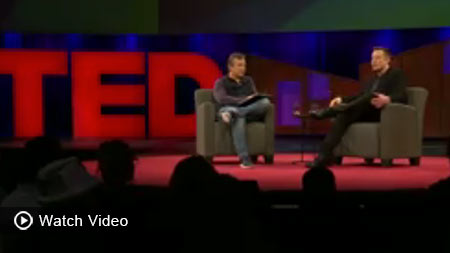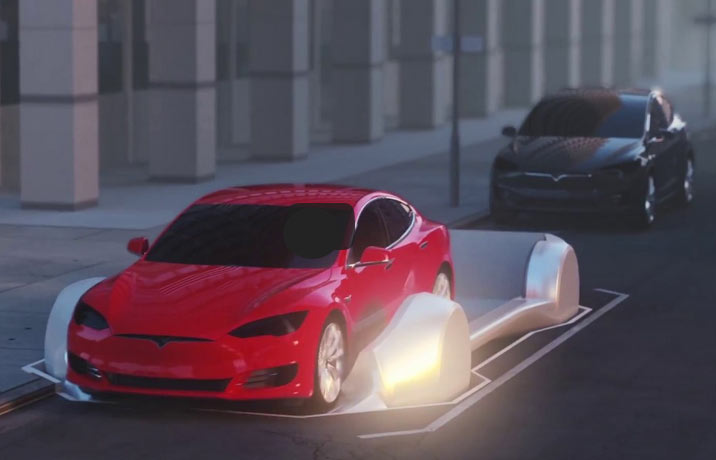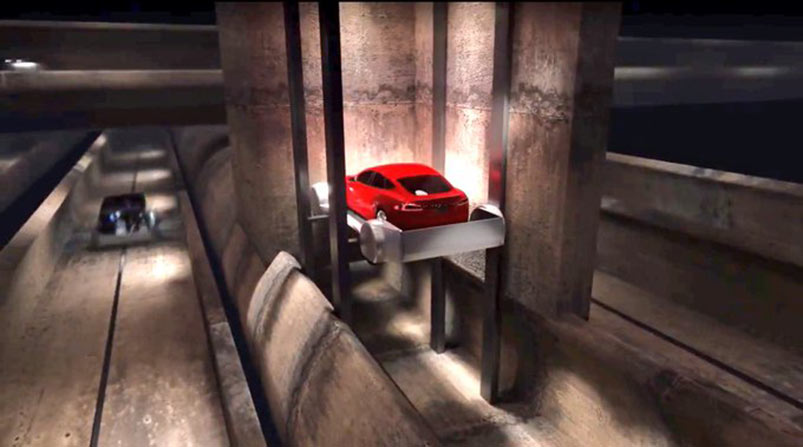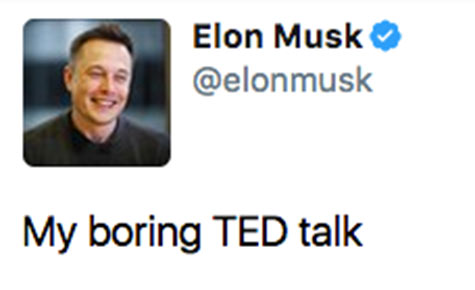-
In support of Musk visions
News that Elon Musk has entered the tunnel boring business has inspired several contributions of Feedback, from support and agreement to some of his points in principle, to notes on fact checking. See the Feedback section at the bottom of this article page and also the full texts on the Feedback page. Contributions are from Lok Home of The Robbins Company; James Wonneberg, tunneling engineer, USA; a retired tunneling engineer of the UK and the TunnelTalk Editor.
To have your say and contribute to the discussion, send your thoughts to Feedback@TunnelTalk.com
Musk talks tunnelling concepts May 2017
Billionaire entrepreneur, inventor and engineer Elon Musk is expanding his interest in underground infrastructure and has outlined a three-step strategy to develop a new tunnelling system to build a network of urban road tunnels and excavate the infrastructure at a faster and cheaper rate.

Elon Musk explains his tunnel network vision
Edited excepts from TED Conference interview
Speaking on the last day of the 2017 TED (Technology, Entertainment, Design) media organization conference, in Vancouver in April, Musk said the technology would deliver the tunnelling economics needed to achieve his vision for a multi-level road tunnel network spreading out under major cities. Los Angeles, the car capital of the world, and now suffering chronic freeway traffic congestion during rush hours, is targeted as the first to undergo the transformation.
The strategy is focused on smaller diameter tunnels, more powerful boring equipment, and simultaneous excavation and lining. He believes the three-pronged combination could deliver a tenfold improvement in underground construction economics.
To develop the concept of the 3D road tunnel network, Musk advocates what he calls “a fairly straightforward series of steps” to obtain in tunnel technology improvements and reap commensurate construction cost benefits.
First, he explains, multi-lane road tunnels are not wanted. Instead, his concept is for vehicles not to be driven, but rather carried on individual electric shuttle platforms, or “car-skates”, along narrower, single lane road tunnels. To that end, Musk is looking to cut the diameter of road tunnels by at least half the current standards for a single lane road tunnel of 7.9m-8.5m (26ft-28ft) diameter, including allowance for safety, ventilation, access and emergency facilities.
“If you shrink that diameter to 3.7m (12ft), which is plenty to get an electric through,” Musk said, “you drop the diameter by a factor of two and the cross-section by a factor of four, and the tunnelling cost then scales back with cross-sectional area.”
Second, Musk is exploring design of tunnelling machines to install the lining while continuing excavation.
“Tunnelling machines currently excavate for half the time, then they stop, for putting in reinforcements for the tunnel lining,” he said. “So, if you design the machine instead for continuous tunnelling and reinforcing, that will give you a factor of two improvement.”
Third, in terms of the equipment muscle, Musk believes more can be done.
“Also, these machines are far from being at their power or thermal limits, so you can jack up the power to the machine substantially. I think you can get at least a factor of two, or maybe a factor of four or five, improvement on top of that,” he suggests.
All together, Musk believes the various changes to the technological approach to tunnelling systems could deliver “an order of magnitude improvement,” or cut about 90% off, the cost per mile to build the narrow road tunnels he envisages for his subterranean traffic labyrinth.
Musk brought his spotlight to underground technology following his public complaint (via Twitter, in December 2016) about the severe traffic congestion issues in Los Angeles. He soon added his notion to bypass – or even totally avoid – the gridlock.
At the TED event, Musk explained that he envisions toll payments would be involved, giving drivers – and ulimately driverless vehicles – access to the nested layers of road tunnels.
An animated video illustrated how the maze would be entered, and it is radically different to the current system of using long access ramps for cars to drive underground. Instead, the concept is to park on the surface on special lift shafts, capable of taking a single vehicle below ground. The vehicles would descend on special platforms, remaining securely held on the electric car-skates that would subsequently shuttle along the tunnels at speeds of up to 200km/hr (125mph), he said.
“You have to be able to integrate the entrances and exits seamlessly into the fabric of the city,” said Musk, suggesting that entrances and exits could require surface areas equivalent to “parking spaces”.
Musk advocated his view of the 3D network as offering “no real limit to the levels of tunnel you can have”, citing the extensive use underground levels in the mining sector.
He explained that the team at his aptly named The Boring Company has been looking at the tunnelling questions for some months. He told the TED conference audience that he spends only 2%-3% of his time on the research area and that the effort is supported with some in-house input from his team at the headquarters of SpaceX, his rocket development business. He is also developing electric vehicle technology through his Tesla Motors company. Before these ventures he made his fortune in software.
He added that the tunnelling system could have application for his sponsored HyperLoop system, which is another small tube transport shuttling system aimed at propelling loaded freight or other pods at high speed in sealed vacuums.
TunnelTalk is following also the different developments in the field of hyperloop technology and will publish news of the concepts in a coming issue of the web magazine.
References
- In search of the Age of the Underground in the UK – TunnelTalk, March 2016
- TBM innovations approach field testing – TunnelTalk, November 2015
- Hydroshield and extruded lining usage in Lyon – TunnelTalk, January 2013
Feedback
Advancing the tunneling industry the Elon Musk way
Recent reporting of Elon Musk and his vision for inspiring and spearheading technological developments in the tunnelling industry has generated several points of Feedback, from support and agreement to points in principle, to notes on fact checking.
Feedback from: James Wonneberg, Co-Founder & CEO, GraphicSchedule.com
Elon Musk’s interest in tunneling is not new. In fact, he has been talking about the need for 3D networks of tunnels for years. I have always found him and his proposals and ideas fascinating, and check his Twitter account regularly for updates. So I was thrilled when he announced his intention to “build a tunnel boring machine and just start digging”.
Those who follow along, know that Musk’s tweets are carefully worded announcements that carry a lot of weight. I knew right away that our industry could soon be swept forward with the same rapid acceleration that the automobile and space industries have felt already, fueled by one of the greatest innovators of our time. For a glimpse into how Musk and his companies operate, pick up a copy of Elon Musk: Tesla, SpaceX, and the Quest for a Fantastic Future by Ashlee Vance. It is a dynamite read.
Right after the initial tweet on 17 December 2016, I started working my network to try to make contact. My thinking was, basically, I work on tunnels…surely Musk will need my help to put a plan together. (Ha!) A friend of mine in Silicon Valley eventually found the guy at SpaceX leading this effort, and reached out to introduce me via email. To my surprise, he responded. Amazing! We connected for a quick phone call – and I mean quick. He spoke lightning fast, which, it turns out, is how Musk's companies do just about everything.
We exchanged some rapid-fire questions about their mission, then he informed me that they planned to break ground on the entry shaft within a few weeks (check) and expect to be digging tunnel within a few months (believe it). As we have heard in Musk’s remarks at the recent TED conference in Vancouver, he wants to improve tunneling speed by 500% to 1,000%, which will make the underground more accessible for all sorts of infrastructure.
You see, these guys are not waiting around for industry roundtable discussions, feasibility studies, and the like. They are tackling this from a completely different ‘first principles’ angle and approach. Count me in the camp that believes this sort of thinking will have a very positive impact on this great profession of ours. It saddens me when industry giants scoff and shake their head in unison about Musk’s chances of success. But this reflects more on our own imagination than it does on the innovator himself. For sure there will be bumps along the way, but - given his track record – who is going to bet against Musk?
Tunneling on Mars, anyone?
James Wonneberg
Co-Founder & CEO
GraphicSchedule.com
Feedback from: Lok Home, President, The Robbins Company, from the company website blog
“I was inspired to write for the company blog following announcement that Elon Musk is entering our business—the tunnel boring business. It is great to see people with a vision of an improved world enter our industry. I agree with Musk that the advance rate of tunnels can be significantly improved if development money comes into the industry. Development money in tunneling, however, is at best minimal and is more often essentially non-existent. Nearly all tunnels are heavily specified to avoid risk taking by owners (therefore discouraging new development). Nearly all tunnels go to the lowest bidder and low bidders try to buy the TBMs at the lowest price; a further discouragement of development. The industry has therefore been slow to improve advance rates, but with Musk bringing the issue into the spotlight, perhaps things will change.”
Lok Home
President
The Robbins Company
Feedback from: Retired tunnelling engineer in the UK
“I have always considered that we could and should be achieving a kilometer a week in advance rates. Lining operations slow up progress but techniques could be developed for using the minerals in the earth itself to create the tunnel lining in-situ – methods of vitrifying the walls of the tunnel behind the advancing TBM for example.”
TunnelTalk in reply: Back in the early 1980s, at the height of the ‘cold war’ with what was then the USSR, a notion was circulated among tunnelling engineers that the Soviet Union was using nuclear detonations to create the massive caverns needed to house hydropower plants and military arsenal bunkers. NASA in the United States funded a project to know if operation of a TBM, working through hard rock, could be detected by satellites. The proposal was to use TBMs to excavate as-needed missile silos, rather than have them pre-excavated and equipped to house missiles in readiness. The results of the study are unknown at this moment and collapse of the Soviet Union regime superseded the need for self-excavation of missile launching silos.
Fact checking re cost of Los Angeles Metro construction
TunnelTalk Editor: In his TED interview at the Vancouver conference, (and as published on TunnelTalk), Musk answers the suggestion that tunnels are expensive to build by stating as an example that a “LA subway extension, which is 2.5 miles long, was just completed for $2 billion.”
On checking the facts, it is difficult to understand which of the Los Angeles Metro projects he is referring to.
Of recent Metro projects, the Gold Line, is the most recently completed addition to the network. The new 6-mile extension with eight stations into East Los Angeles is mostly at grade, with a 2-mile section of twin tube running tunnels and two underground stations beneath Boyle Heights. It was completed and opened to service in November 2009 at a civil construction contract cost of US$600 million (about $300 million for the underground works) and a total project cost of US$898 million. An average of $166 million per mile.
The Crenshaw-LAX Line, which is currently in construction is 8.5-miles long $2.058 billion project and is also mostly at grade with a maximum 1.9-miles in bored tunnel to link three underground stations. It is scheduled to go into service in 2019 and is being constructed for a total construction cost of US$1.3 billion including M&E installations. An average of about $238 million per mile.
The Regional Connector in Downtown Los Angeles, to connect the Metro Blue, Gold and Green Lines is 1.9 miles long, has three new underground stations and comprises sections of open cut work, twin tube TBM bored tunnels and a SEM crossover structure. It is being constructed for a total US$927.2 million and is scheduled to open for service in 2020. Less than $500 million per mile.
The Purple Line Extension along Wilshire Boulevard to Westwood is a 9-mile long, all underground, twin-tube TBM bored running tunnel project with seven cut-and-cover underground stations, and has a forecast estimated construction cost of US$6.3 billion. This is an estimaded average of about $700 million per mile.
Its construction is divided into three stages.
Stage 1 is 3.9 mile and includes three underground stations. Construction started in November 2014 and the design-build construction contract for the twin tube tunnels and the underground station civil works was awarded for a total of $1.636 billion. The total estimated $2.821 billion section is due to open in 2023. About $770 million per mile.
Design-build construction of Stage 2 of the project, at 2.62 miles and with two underground stations, was awarded in February 2017 for a civil works contract price of US$1.37 billion. It is due to open in 2026. About $523 million per mile.
The third and final State 3 of the current Purple Line Extension project to Westwood is 2.48 miles long and has two underground stations. Its civil works contract is yet to be tendered.
|
|
|
|
|
Add your comment
- Thank you for taking the time to share your thoughts and comments. You share in the wider tunnelling community, so please keep your comments smart and civil. Don't attack other readers personally, and keep your language professional.




